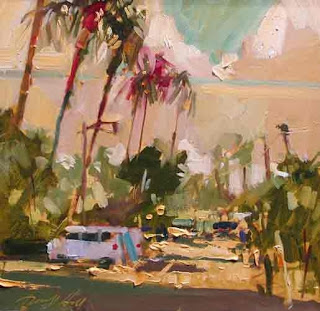And a final thought. When is the painting done? The short answer is "never". The long answer is whenever you have said what you set out to say.
I am in Sonoma , Ca participating in the Plein Air event. It is a new event for me so I was a bit nervous. I didn't know the area -which is ok- but there is a competitive aspect to it, a desire to prove the organizers that they juried you in for a reason , be it sales or quality, and there's the pressure of time.
So that got me thinking, when is a painting done, or rather, when do we leave the painting alone.
"Mossy Monsters, jack London State Park" 12"x16" One of my more "finished" plein air pieces.
"Jack London Inn, Glen Ellen, CA" 8"x10" An intentionally less worked-over piece but may be more "done" than the oaks above.
Of course, everyone has a different idea and that's ok. Here are some thoughts:
Detailing. Nature is infinitely detailed. No painting will match nature or a photo in detail. Ever. So it can't be just about the detail. Especially if you are en plein air, detail is a relative concept and interestingly enough comes mostly from the brush stroke itself , the edges and the washes, not how much work goes into every leaf. Striking a balance between detail and not-so-detail. This painting below is "Back Harbor Road" 12"x12" from Hawaiian artist
Darrell Hill and it illustrates the idea of sourcing the detail from the brushstroke. He is "done" with this piece.
Highly detailed, every hair and cranny paintings are a tradition and an aspiration from the dawn of oil painting and even before. Every painting needs to keep your interest somehow and create or recreate its reality. You have to be a virtuoso to pull detail off on a smooth surface without a lot of painterly fireworks. Some very excellent painters :
Richard Dadd,
Norman Rockwell,
Andrew Wyeth,
Peder Mørk Mønsted,
Daniel Smith come to mind, have done wonderful detail work and managed to keep the painting fresh at almost microscopical levels without loosing sight of the fact that they are painting.
Photorrealism. Painting from a photo is a valid mechanism. But again, if your painting ends up looking like a photo you haven't done your homework or you are going for virtuosity -which is highly valued in illustration. But I've often seen paintings with lens flares, blurry cars, people in awkward poses, color hue shifts or deep deep darks that betray their photographic origin rather than artistic decisions. A painting might start with a photo but it can't possibly end there. So a painting is not "done" if it looks and feels like the photo it came from.
Experimenting. What does experimenting have to do with completion? Well, a favorite quote of many artists and mine too -you've heard this, you've said this, usually after a two hour nasty struggle with your canvas: "I was just experimenting." -Aha! I failed, so it must be an
experiment. Noooot so quick buster, I am not getting away with it. Admit it Jose, you set out to do a masterpiece. You might have been even just
practicing (practicing is when you are not experimenting, just like an athlete is not experimenting when he trains fro the marathon) but that thing you just called an experiment is staring back at you looking every bit the nasty mess it is. Well then. You are not "done". Done for the day may be but not done with the painting. Pull out the spatula and wipe it out. No, it won't look better tomorrow when the elves come fix it at night.
Experimenting requires that you set out to try something new to you, be it a new material, technique or even a new mental attitude. You open yourself to the possibility of failure, sure, but you walk in with your eyes wide open just in case you discover something new as well. Experimenting is as conscious as everything else.
Failure just happens and is as necessary as it is hard to handle but hey, in the field nobody hears you curse so tell that cow how you really feel.











